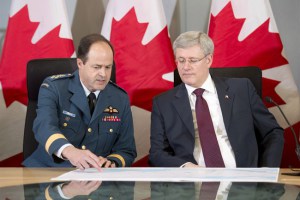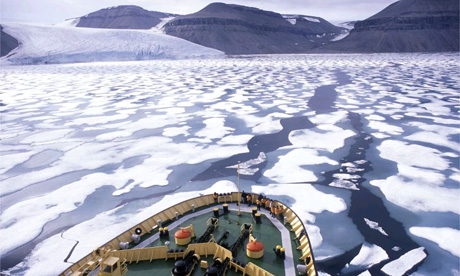This evening at the National Club, the NATO Council of Canada will host Jim Dickmeyer, Consul General of the United States in Toronto, for an informal discussion on the future of North American security.
Protecting twenty-five million square kilometers is, practically speaking, not easily done. However, North American security – indeed, North America itself – is perhaps an even greater challenge in conceptual terms. While North America includes all of twenty-three states, the process of North American integration focuses on its three largest: Canada, the United States, and Mexico. Further still, within this triumvirate, North American security is far from an even trilateral effort.
[captionpix align=”right” theme=”elegant” width=”300″ imgsrc=”http://natoassociation.ca/wp-content/uploads/2013/09/flags.jpg” captiontext=”North American integration is the project of its three largest countries (from left to right): Mexico, the United States, and Canada”]
In truth, North American security is the sum of mostly bilateral agreements between the United States and each of its terrestrial neighbors. In other words, three-way ties between the United States, Canada, and Mexico, and bilateral ties between Canada and Mexico, pale in comparison to their respective ties to the United States.
As the NATO Council prepares to examine the future of North American security this evening, it is important to consider the status quo and question the feasibility – or indeed, advisability – of future trilateral efforts.
Though still in its infancy today, the North American security project can be traced as far back as the Second World War, when geographic realities prompted Canadian Prime Minister King and US President Roosevelt to approach North America as a single military theatre. As early as 1938, King and Roosevelt recognized that defending each other and their continent was integral to defending themselves. The establishment in 1940 of the Permanent Joint Board of Defense and the 1946 founding of the Military Cooperation Committee are products of this realization.
[captionpix align=”left” theme=”elegant” width=”300″ imgsrc=”http://natoassociation.ca/wp-content/uploads/2013/09/rooseveltking.jpeg” captiontext=”Close personal ties between President Roosevelt (left) and Prime Minister King supported bilateral integration efforts.”]
Though the Cold War represented a very different kind of threat to Canada and the United States, cooperation with respect to continental security continued. The 1958 North American Aerospace Defense Agreement and Command (later NORAD) continues to serve as the framework for the US and Canada in their efforts to defend North America today.
Military cooperation between the United States and Mexico can also be traced back to the Second World War. As early as June 1940, Mexican President Lázaro Cárdenas offered Mexican support against Axis powers alongside other nations of Latin America. However, bilateral arrangements such as the formation of the Joint Mexican-US Defense Commission (JMUSDC) in 1942 were somewhat hindered by Mexican political sensitivites vis-à-vis the United States.
The question of trilateral security cooperation was scarcely raised until the entry into force in 1994 of the North American Free Trade Agreement. Some observers saw security cooperation as a natural progression from economic integration. However, given the expectation of peace dividends following the Cold War, continental security was not prioritized during the 1990s.
[captionpix align=”right” theme=”elegant” width=”300″ imgsrc=”http://natoassociation.ca/wp-content/uploads/2013/09/NAFTA.jpg” captiontext=”Officials from Mexico, the United States and Canada signed the North American Free Trade Agreement (NAFTA) in 1992, while their respective leaders – from left to right, Carolos Salinas, George Bush, and Brian Mulroney, looked on.”]
It was not until September 11, 2001 that the question of cooperative continental defense was once again raised seriously. To this end, the United States established the Department of Homeland Security and the US Northern Command (NORTHCOM) in 2002. NORTHCOM in particular is responsible for working with Canadian and Mexican military authorities to strengthen North American defense. Shortly after 9/11, the US also signed a Smart Border Declaration and Action Plan with each of its terrestrial neighbors.
It is important to emphasize, though, that these examples of continental integration – NAFTA, NORTHCOM and Smart Border agreements – are barely trilateral. NAFTA, for example, can be traced back to the 1987 Canada-US Free Trade Agreement (CUFTA). The agreement is trilateral today because Canada feared exclusion from a similar arrangement between the US and Mexico.
Similarly, while NORTHCOM is indeed a forum for American, Canadian, and Mexican military authorities to collaborate, its primary motivation is the protection of the United States. Given that Canada and Mexico present very different threats to the United States, the potential for uniform trilateral action is limited. Finally, it is also important to note that the Smart Border Agreement between the US and Mexico was signed separately, and after, a similar agreement between the US and Canada.
The slow progress of trilateral efforts is made clearer still by the fate of the North American Security and Prosperity Partnership (SPP), negotiated at a high-profile summit between Canada, the United States and Mexico in 2005. The agreement called for further cooperation on border controls, transportation and emergency planning measures. It was heralded at the time as an undeniable step towards a more integrated and secure North America.
[captionpix align=”left” theme=”elegant” width=”300″ imgsrc=”http://natoassociation.ca/wp-content/uploads/2013/09/waco.jpg” captiontext=”US President George W. Bush hosted Canadian Prime Minister Paul Martin, left, and Mexican President Vicente Fox, right, during their trilateral meeting in Waco, Texas (2005).”]
However, in truth, the SPP deals mostly with regulatory issues on migration and automobile integration. Although defense and security cooperation is certainly included in this partnership, it is limited to maritime and port surveillance, and matters of defense are disproportionally addressed in this agreement by Canada and the United States.
It is clear, then, that North American security is not a true trilateral effort, but rather the sum of bilateral efforts. The obvious question to follow this account is why attempts at North American perimeter have failed.
Briefly summarized, the failure of continental trilateralism may be attributed to the fact that each of the three large parties involved has very different priorities with respect to national security and, as a consequence, continental security.
The United States, for example, prioritizes national security above all else. However, it has a different agenda per border according to the nature of the perceived threat from each neighbor. To the north, the US wants to secure Canadian borders. To the South, the US still seeks to secure its own.
This attitude stands in contrast to the Canadian government, which prioritizes economic linkages, and Mexico, where issues such as drug trafficking, migration patterns and economic development figure prominently on its foreign policy agenda.
What’s more, with respect to Mexico, the extent of its domestic insecurity means that trilateral agreements are unlikely to take full effect in this country. Weak and corrupt institutions make for a very different policy-making process. In short, one cannot propose equal measures across countries with unequal capacities.
Generally speaking, the future of North American security depends on the extent of common ground between each of these three countries. Despite different priorities, there is unquestionably room for cooperation. However, North American security will undeniably progress and improve at a faster rate if each country commits to cooperation with either or both of its partners.
While this ad hoc manner of policy-making may be unattractive to proponents of a Big Idea, it is the most reliable and rapid form of progress. Trilateral efforts between Canada, the United States and Mexico can only realize the lowest common denominator of parties involved, and in areas such as peace and security, minimalism is hardly advisable.




